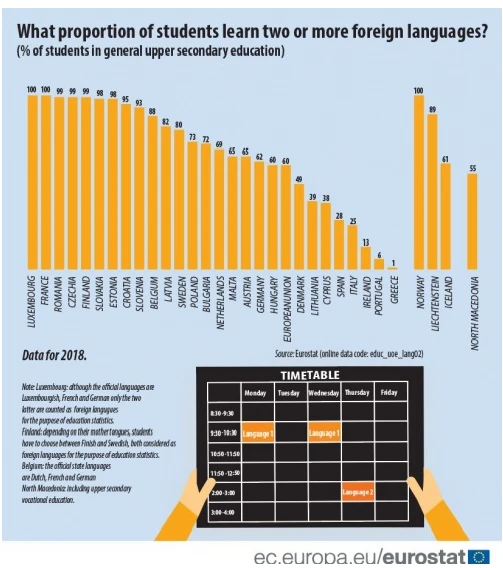It’s hard to imagine any school without a foreign language class. In certain educational establishments, students learn two languages and more. For instance, in some European countries, including Luxembourg and France, all students in general upper secondary education learn at least two foreign languages:

Why do students need to learn foreign languages?
The answer goes far beyond potential employment and career benefits:
- Instilling respect for other peoples and cultures.
- Expanding the student’s worldview.
- Liberalizing the student’s attitude towards others.
- Facilitating tolerance and acceptance.
- Promoting open-mindedness.
As you can see, learning a foreign language can be a powerful instrument in building a student’s personality and identity. And, of course, teaching methods play an important role in bringing the above-mentioned benefits to life.
Over the past few years, more and more educators talk about the importance of interactive technologies and digital resources in teaching foreign languages. Today, we’re going to discuss the advantages of digitization in foreign language instruction and take a look at a few resources available to teachers.
Article Contents
Why Do Interactive Technologies Matter in Education?
It’s fair to say that educational technology still has a long way to go in terms of both development and implementation. Nevertheless, Ed-Tech and interactive technologies, in particular, have proven their effectiveness in learning.
A case study from the University of Dublin has shown that students receive interactive technologies quite well. In particular, boys have expressed a more eager attitude towards using interactive tools during classes, saying they help retain information better.
Both teachers and students described the following benefits of interactive technologies:
>> The process of learning becomes more “visible.”
>> Interactive technologies make it easier to personalize the instruction.
>> Students become more engaged; their attention span increases.
>> Interactive technologies facilitate problem-solving and self-reflection.
>> Instruction becomes more diverse as teachers get new resources.
All these advantages also apply to teaching and learning foreign languages. Visual aids play an important role in perceiving and retaining information on grammatical and lexical constructs. And, self-reflection is an important skill every foreign language learner needs to evaluate their skills.
That being said, the study also confirms that most teachers are still reluctant to use interactive technologies and more diverse digital resources during a class, relying on PowerPoint presentations too much.
Interactive Technologies and Digital Resources for Foreign Language Lessons
Now, let’s take a look at the tools foreign language teachers have currently available to them online. The list is not abundant, but there are enough interactive resources to diversify your instruction.
1. More Engagement with Gamification
Gamification is a teaching method to encourage students to learn using elements of the game. This way, students get a chance to interact with the environment and retain new knowledge longer.
The gamification method has existed in foreign language teaching for many years. For instance, flashcards are a gamification element that teachers use during every activity that involves learning new vocabulary.
Today, you can create any kind of game using online tools, such as Kahoot! Besides, you can also check the games created by other teachers and use them during your classes. For example, if you’re currently teaching your students basic French words and phrases, you will find this game quite useful:
The game teaches students home-themed vocabulary using a quiz. It’s a fun and effective way for your students to check their knowledge of new words.

The game teaches students home-themed vocabulary using a quiz. It’s a fun and effective way for your students to check their knowledge of new words.
2. Student-Teacher Interactions with Collaboration Platforms
Students need a strong connection with their teachers.
According to the American Psychological Association, a good teacher-student relationship has a positive and long-lasting impact on students’ social development and academic achievements.
Close interactions between teachers and students are also important for successful foreign language instruction, which involves collaboration on all levels. And that’s where collaboration tools enter the scene.
For instance, Show.me, an online collaboration platform, helps teachers connect with students, keep track of all their assignments, and conduct quizzes to check their proficiency levels. Besides, teachers can also film a quick explainer video to introduce grammatical/lexical/stylistic constructs. Here’s an example of such a video about the imperfect tense in Spanish:

These videos can come in handy for students who need some extra help understanding some linguistic phenomena. Students can leave comments and interact with their teachers in real life to get their questions answered.
3. Visual Aid with AR and VR Technology
As you already know, foreign language instruction relies heavily on visual aids to help students retain information better. The reason is simple – 65% of people are visual learners and perceive visualized information better.
Over the past few years, the role of AR and VR as interactive visual aids in education has grown immensely. These technologies put a student in a situation which they have to control using the knowledge they have.
Speaking about foreign languages, AR apps are a great way for students to practice real-life conversations. Here’s a great example from Mondly AR:

Apps like Mondly AR create a classroom setting in which a student interacts with a virtual teacher to learn a foreign language. Such an approach is especially beneficial during the pandemic when students have to study remotely, and their learning resources are limited.
Aside from AR and VR, mobile applications can also be very helpful in foreign language instruction. Teachers can use them as additional tools to help students practice phenomena learned during the class. Mobile apps also have a gamification element to them, which means that they also boost student engagement.
Over to You
Interactive technologies and digital resources are undoubtedly valuable for teaching foreign languages. They bring along the benefits that other teaching methods don’t have:
<> visualizing the process of learning
<> personalizing the learning process
<> making students more engaged
<> improving self-reflection
<> making instruction more diverse
Nowadays, teachers have quite a few interactive technologies available to them, including gamification tools, collaboration platforms, AR, VR, and mobile apps. Although these solutions still need refining, they have already proven effective in helping students learn foreign languages faster and more efficiently.

